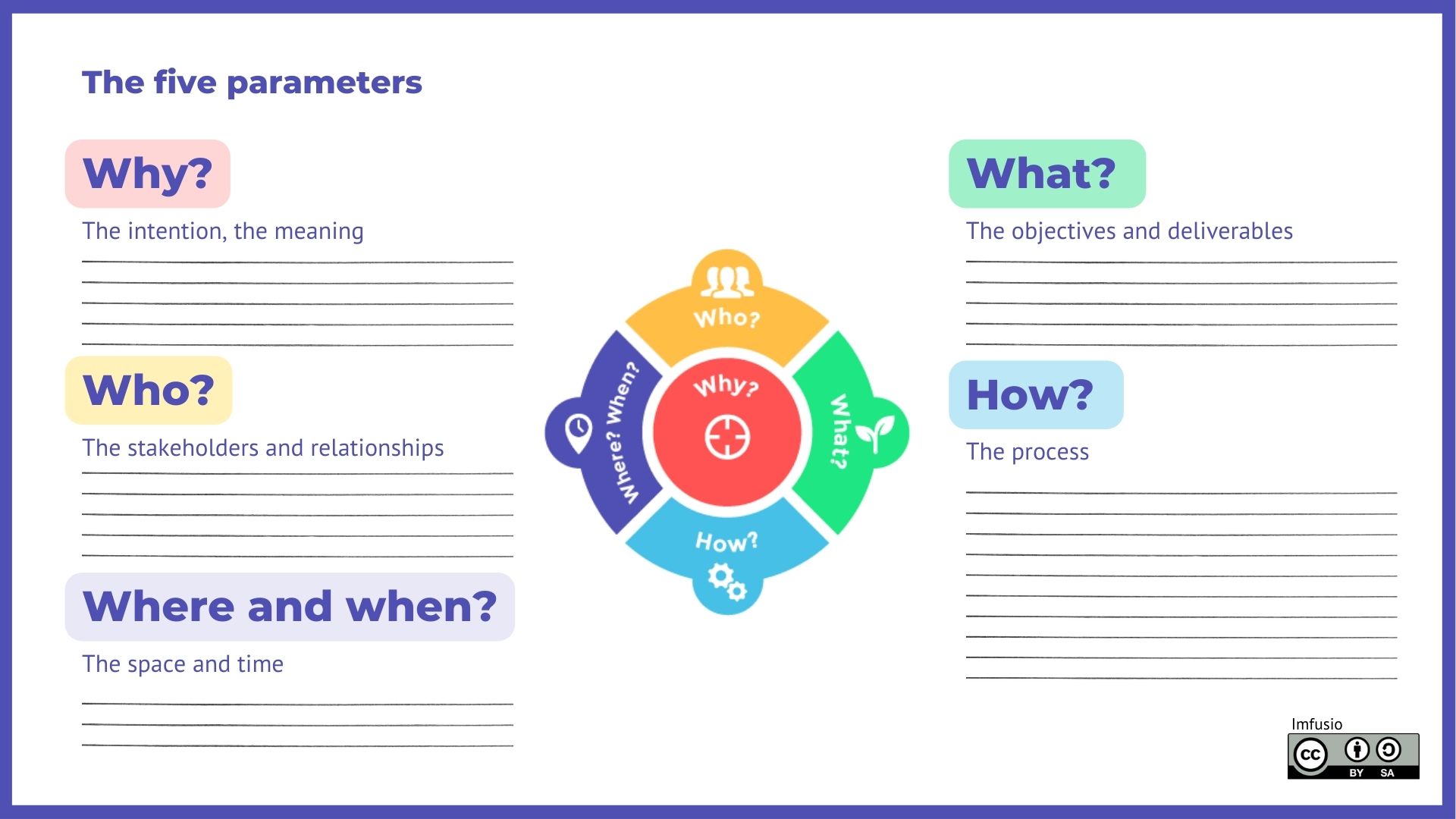The five parameters
How to structure a collective intelligence session
The five parameters
How to structure a collective intelligence session
The “five parameters” are a tool that we can use to prepare and structure a meeting, seminar, project or process, factoring in all the elements that are necessary to really awaken the group’s collective intelligence.
Time needed: 30 minutes to 2 hours
Matérials:

To prepare for an upcoming collective intelligence session as effectively as possible, invite the organisers to go over the five parameters presented below.
We generally start with “Why”. It’s also advisable to go back to this question at every stage of your working session, regularly asking the following question: “Are our intentions still on track or do we need to adjust or redirect them?”
“Why are we using collective intelligence?” “Where are we today and why do we need to be together?”
The reason we gather together in groups is to respond to a complex question.
To give sense to group sessions, it’s important to express it in the form of an intention. This comes from the leader, but it must speak to everyone, which is why it’s important to revisit it with the organisers, and even the participants of the collective intelligence session.
Clarity of this intention is also key to the success of any collective intelligence task. By “intention”, we mean the “aspiration, “desire” or even “drive” arising from an observation or context.
It’s therefore important to define what the group is striving to achieve, what is motivating their actions (the meaning, direction behind them), and not their aim (what we could also refer to as the “result” or “target”).
E.g.: the intention of a seminar may be to “bring together all the right people to reflect on how we can re-invent the construction sector to make it more attractive, with as little impact on the planet as possible.” Whilst its aim is to form the appropriate working groups.
“Who does the topic concern, either directly or indirectly?” “Who do the organisers want to involve in this collective intelligence session?” “What are the existing relationships between the participants and what relationships do the organisers want to create?” “Who are the facilitators and what links to they have with the participants?” “What do we do about absentees?”
Diversity is important here: invite different roles, specialisms and profiles to provide a range of perspectives. It may even be useful to involve external parties, depending on the context.
Initially, the organisers should list all the stakeholders to be taken into consideration.
With this list in mind, the group can then identify who needs to be present during the meeting, seminar or working session.
“How can the space encourage the participants to let go, breathe and innovate?”
Vast, open, light spaces provide the perfect conditions for working together and being creative.
The physical space is an important resource, every corner of which must be exploited:
Timing is also important. Encourage the organisers to respond to the following questions:
“What do we want to start with?” “What deliverable do we want to produce from this collective intelligence session?”
Every meeting must set aside time for convergence and “collecting ideas”, using a method that is coherent with the context and intention.
This stage is fundamental as it enables the group to ensure that:
The idea collection phase operates on two levels:
It can take different forms in line with the group’s needs (keeping track, sharing, etc.) and the methods and techniques used:
Once the results have been consolidated, they are usually sent to the workshop participants.
You could also circulate them even wider, depending on how useful it may be for your specific project.
“Which techniques and inspiring questions can we use to get the most out of the session?” “What order would be most seamless?”
All collective intelligence approaches require an engaging line of questioning and suitable facilitation techniques.
These techniques, like the entire collective intelligence process, are based on the participation diamond and more broadly on a set-up that provides time for individual reflection, plenary sessions, small group work and true convergence.